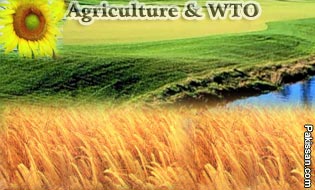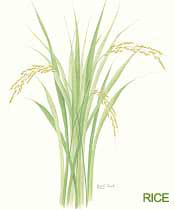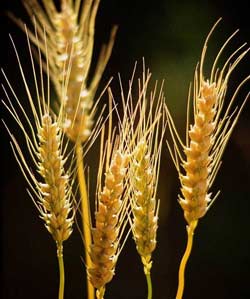|
WTO Agreement on
Agriculture
The negotiations have resulted in four main portions of the
Agreement; the Agreement on Agriculture itself; the
concessions and commitments Members are to undertake on market
access, domestic support and export subsidies; the Agreement
on Sanitary and Phytosanitary Measures; and the Ministerial
Decision concerning Least-Developed and Net Food-Importing
Developing countries.
 Overall,
the results of the negotiations provide a framework for the
long-term reform of agricultural trade and domestic policies
over the years to come. It makes a decisive move towards the
objective of increased market orientation in agricultural
trade. The rules governing agricultural trade are strengthened
which will lead to improved predictability and stability for
importing and exporting countries alike. Overall,
the results of the negotiations provide a framework for the
long-term reform of agricultural trade and domestic policies
over the years to come. It makes a decisive move towards the
objective of increased market orientation in agricultural
trade. The rules governing agricultural trade are strengthened
which will lead to improved predictability and stability for
importing and exporting countries alike.
The agricultural package also addresses many other issues of
vital economic and political importance to many Members. These
include provisions that encourage the use of less
trade-distorting domestic support policies to maintain the
rural economy, that allow actions to be taken to ease any
adjustment burden, and also the introduction of tightly
prescribed provisions that allow some flexibility in the
implementation of commitments. Specific concerns of developing
countries have been addressed including the concerns of
net-food importing countries and least-developed countries.
The agricultural package provides for commitments in the area
of market access, domestic support and export competition. The
text of the Agricultural Agreement is mirrored in the GATT
Schedules of legal commitments relating to individual
countries (see above).
 In
the area of market access, non-tariff border measures are
replaced by tariffs that provide substantially the same level
of protection. Tariffs resulting from this "tariffication"
process, as well as other tariffs on agricultural products,
are to be reduced by an average 36 per cent in the case of
developed countries and 24 per cent in the case of developing
countries, with minimum reductions for each tariff line being
required. Reductions are to be undertaken over six years in
the case of developed countries and over ten years in the case
of developing countries. Least-developed countries are not
required to reduce their tariffs. In
the area of market access, non-tariff border measures are
replaced by tariffs that provide substantially the same level
of protection. Tariffs resulting from this "tariffication"
process, as well as other tariffs on agricultural products,
are to be reduced by an average 36 per cent in the case of
developed countries and 24 per cent in the case of developing
countries, with minimum reductions for each tariff line being
required. Reductions are to be undertaken over six years in
the case of developed countries and over ten years in the case
of developing countries. Least-developed countries are not
required to reduce their tariffs.
The tariffication package also provides for the maintenance of
current access opportunities and the establishment of minimum
access tariff quotas (at reduced-tariff rates) where current
access is less than 3 per cent of domestic consumption. These
minimum access tariff quotas are to be expanded to 5 per cent
over the implementation period. In the case of "tariffied"
products "special safeguard" provisions will allow additional
duties to be applied in case shipments at prices denominated
in domestic currencies below a certain reference level or in
case of a surge of imports. The trigger in the safeguard for
import surges depends on the "import penetration" currently
existing in the market, i.e. where imports currently make up a
large proportion of consumption, the import surge required to
trigger the special safeguard action is lower.
Domestic support measures that have, at most, a minimal impact
on trade ("green box" policies) are excluded from reduction
commitments. Such policies include general government
services, for example in the areas of research, disease
control, infrastructure and food security. It also includes
direct payments to producers, for example certain forms of
"decoupled" (from production) income support, structural
adjustment assistance, direct payments under environmental
programmes and under regional assistance programmes.
 In
addition to the green box policies, other policies need not be
included in the Total Aggregate Measurement of Support (Total
AMS) reduction commitments. These policies are direct payments
under production-limiting programmes, certain government
assistance measures to encourage agricultural and rural
development in developing countries and other support which
makes up only a low proportion (5 per cent in the case of
developed countries and 10 per cent in the case of developing
countries) of the value of production of individual products
or, in the case of non-product-specific support, the value of
total agricultural production. In
addition to the green box policies, other policies need not be
included in the Total Aggregate Measurement of Support (Total
AMS) reduction commitments. These policies are direct payments
under production-limiting programmes, certain government
assistance measures to encourage agricultural and rural
development in developing countries and other support which
makes up only a low proportion (5 per cent in the case of
developed countries and 10 per cent in the case of developing
countries) of the value of production of individual products
or, in the case of non-product-specific support, the value of
total agricultural production.
The Total AMS covers all support provided on either a
product-specific or non-product-specific basis that does not
qualify for exemption and is to be reduced by 20 per cent
(13.3 per cent for developing countries with no reduction for
least-developed countries) during the implementation period.
Members are required to reduce the value of mainly direct
export subsidies to a level 36 per cent below the 1986-90 base
period level over the six-year implementation period, and the
quantity of subsidised exports by 21 per cent over the same
period. In the case of developing countries, the reductions
are two-thirds those of developed countries over a ten-year
period (with no reductions applying to the least-developed
countries) and subject to certain conditions, there are no
commitments on subsidies to reduce the costs of marketing
exports of agricultural products or internal transport and
freight charges on export shipments. Where subsidised exports
have increased since the 1986-90 base period, 1991-92 may be
used, in certain circumstances, as the beginning point of
reductions although the end-point remains that based on the
1986-90 base period level. The Agreement on Agriculture
provides for some limited flexibility between years in terms
of export subsidy reduction commitments and contains
provisions aimed at preventing the circumvention of the export
subsidy commitments and sets out criteria for food aid
donations and the use of export credits.
 "Peace"
provisions within the agreement include: an understanding that
certain actions available under the Subsidies Agreement will
not be applied with respect to green box policies and domestic
support and export subsidies maintained in conformity with
commitments; an understanding that "due restraint" will be
used in the application of countervailing duty rights under
the General Agreement; and setting out limits in terms of the
applicability of nullification or impairment actions. These
peace provisions will apply for a period of 9 years. "Peace"
provisions within the agreement include: an understanding that
certain actions available under the Subsidies Agreement will
not be applied with respect to green box policies and domestic
support and export subsidies maintained in conformity with
commitments; an understanding that "due restraint" will be
used in the application of countervailing duty rights under
the General Agreement; and setting out limits in terms of the
applicability of nullification or impairment actions. These
peace provisions will apply for a period of 9 years.
The agreement sets up a committee that will monitor the
implementation of commitments, and also monitor the follow-up
to the Decision on Measures Concerning the Possible Negative
Effects of the Reform Programme on Least-Developed and Net
Food-Importing Developing Countries.
The package is conceived as part of a continuing process with
the long-term objective of securing substantial progressive
reductions in support and protection. In this light, it calls
for further negotiations in the fifth year of implementation
which, along with an assessment of the first five years, would
take into account non-trade concerns, special and differential
treatment for developing countries, the objective to establish
a fair and market-oriented agricultural trading system and
other concerns and objectives noted in the preamble to the
agreement.
WTO
|
Pakissan.com;
|